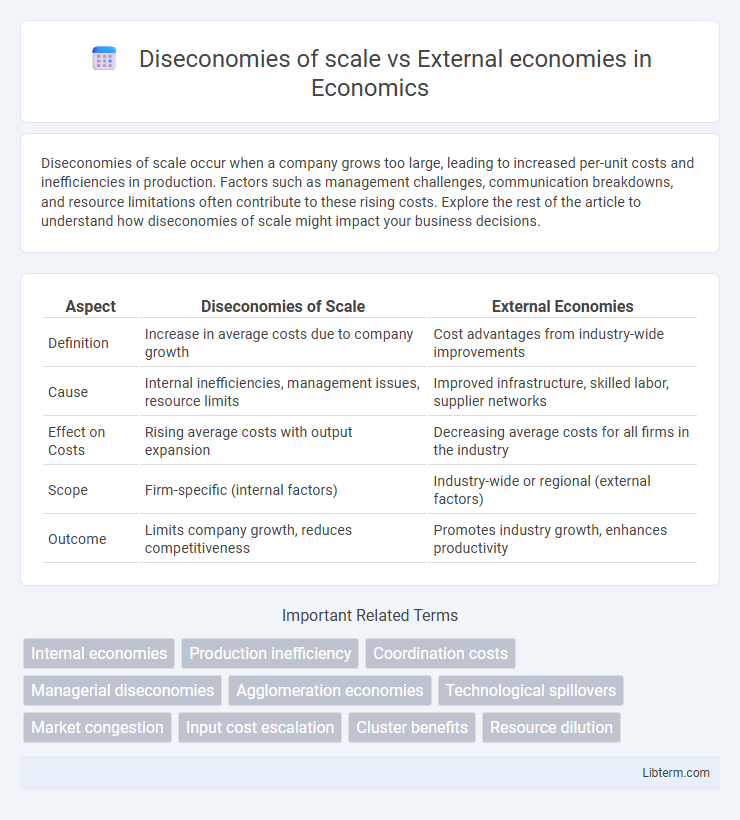Diseconomies of scale occur when a company grows too large, leading to increased per-unit costs and inefficiencies in production. Factors such as management challenges, communication breakdowns, and resource limitations often contribute to these rising costs. Explore the rest of the article to understand how diseconomies of scale might impact your business decisions.
Table of Comparison
| Aspect | Diseconomies of Scale | External Economies |
|---|---|---|
| Definition | Increase in average costs due to company growth | Cost advantages from industry-wide improvements |
| Cause | Internal inefficiencies, management issues, resource limits | Improved infrastructure, skilled labor, supplier networks |
| Effect on Costs | Rising average costs with output expansion | Decreasing average costs for all firms in the industry |
| Scope | Firm-specific (internal factors) | Industry-wide or regional (external factors) |
| Outcome | Limits company growth, reduces competitiveness | Promotes industry growth, enhances productivity |
Understanding Diseconomies of Scale
Diseconomies of scale occur when a firm's production costs increase as output expands, often due to management inefficiencies, communication breakdowns, or resource limitations. This contrasts with external economies, where cost advantages arise from factors outside the firm, such as industry growth or improved infrastructure. Understanding diseconomies of scale is essential for businesses aiming to optimize production and avoid escalating operational expenses.
Key Drivers Behind Diseconomies of Scale
Diseconomies of scale occur when a firm's average costs increase as output expands, driven primarily by factors such as management inefficiencies, communication breakdowns, and increased bureaucratic delays. External economies, in contrast, arise from benefits gained outside the firm, such as improved infrastructure, skilled labor pools, and industry clustering, which reduce costs for all firms in the area. Key drivers behind diseconomies of scale include complexity in coordination, slower decision-making, and rising input prices due to overutilization or scarcity.
Overview of External Economies
External economies refer to cost advantages that firms gain from factors outside their own operations, typically through industry growth or regional development. These benefits include improved infrastructure, specialized labor pools, and knowledge spillovers that reduce production costs across firms within a geographic area. Unlike diseconomies of scale, where increasing internal production leads to higher per-unit costs, external economies lower costs through external improvements shared among businesses.
Sources of External Economies
External economies arise from industry-wide improvements such as technological advancements, skilled labor pools, and infrastructure development that reduce costs for all firms within a location. Unlike diseconomies of scale, which stem from internal inefficiencies as a firm grows too large, external economies benefit multiple firms through shared resources and knowledge spillovers. Key sources include supplier specialization in the area, enhanced transportation networks, and collaborative innovation clusters that boost overall productivity.
Differences Between Internal and External Economies
Diseconomies of scale occur when a firm's internal growth leads to inefficiencies and higher per-unit costs, while external economies arise from industry-wide factors that reduce costs for all firms. Internal economies and diseconomies are linked to firm-specific factors such as managerial ability and resource limits, whereas external economies stem from external conditions like improved infrastructure or technological advancements benefiting the entire industry. The key difference lies in internal economies affecting a single firm's cost structure, while external economies impact multiple firms through shared external improvements.
Comparing Diseconomies of Scale and External Economies
Diseconomies of scale occur when a firm's increased production leads to higher per-unit costs due to inefficiencies such as management complexity and resource limitations. External economies, conversely, arise from industry-wide improvements like shared infrastructure, skilled labor pools, or technological advancements that reduce costs for all firms. While diseconomies of scale negatively impact individual firms as they grow larger, external economies benefit multiple firms simultaneously by enhancing overall production efficiency in a region or industry.
Impact on Business Efficiency and Costs
Diseconomies of scale occur when a business grows too large, leading to increased per-unit costs due to inefficiencies such as management complexity and communication breakdowns. In contrast, external economies arise from industry-wide improvements like technological advancements or improved infrastructure, which reduce costs for all firms without increasing internal complexities. While diseconomies negatively impact business efficiency by escalating operational expenses, external economies enhance efficiency by lowering input costs and fostering competitive advantages.
Real-World Examples of Diseconomies vs. External Economies
In manufacturing, companies like General Motors face diseconomies of scale when increased production leads to coordination inefficiencies and higher per-unit costs, whereas Silicon Valley exemplifies external economies as tech firms benefit from shared knowledge, skilled labor pools, and supplier networks. Similarly, Amazon encounters diseconomies as logistics complexity rises with global expansion, contrasting with the biotech cluster in Boston, where firms capitalize on external economies through collaborative innovation and specialized infrastructure. These real-world examples highlight that diseconomies often arise internally from operational challenges, while external economies stem from beneficial industry-wide spillovers.
Implications for Long-Term Business Strategy
Diseconomies of scale occur when a firm's growth leads to increased per-unit costs due to factors like management inefficiencies and resource limitations, impacting long-term profitability and operational efficiency. External economies of scale arise from industry-wide advantages such as improved infrastructure, skilled labor pools, or technological advancements that reduce costs for all firms within the sector. Long-term business strategies must balance internal growth to avoid diseconomies while leveraging external economies through collaboration, innovation, and strategic location to sustain competitive advantage.
Policy Considerations and Economic Development
Diseconomies of scale occur when increasing production leads to higher average costs, often due to management inefficiencies and resource constraints, while external economies arise from industry-wide benefits like improved infrastructure and skilled labor pools. Policymakers should aim to minimize diseconomies through regulatory frameworks that enhance firm-level efficiency and infrastructure investment, simultaneously fostering external economies by encouraging collaboration and innovation clusters. Strategic focus on balancing these factors supports sustainable economic development by optimizing resource allocation and fostering competitive industries.
Diseconomies of scale Infographic

 libterm.com
libterm.com